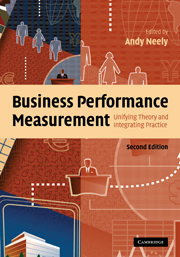Book contents
- Frontmatter
- Contents
- List of figures
- List of tables
- List of boxes
- List of contributors
- Introduction
- Part I Performance measurement – functional analyses and theoretical foundations
- 1 Accounting performance measurement: a review of its purposes and practices
- 2 Measuring marketing performance: research, practice and challenges
- 3 Measuring performance: the operations management perspective
- 4 Measuring performance: the supply chain management perspective
- 5 Finding performance: the new discipline in management
- 6 A conceptual and operational delineation of performance
- Part II Performance measurement – frameworks and methodologies
- Part III Performance measurement – practicalities and challenges
- Part IV Performance measurement in public services
- Part V Performance measurement – emerging issues and enduring questions
- Index
- References
2 - Measuring marketing performance: research, practice and challenges
Published online by Cambridge University Press: 22 September 2009
- Frontmatter
- Contents
- List of figures
- List of tables
- List of boxes
- List of contributors
- Introduction
- Part I Performance measurement – functional analyses and theoretical foundations
- 1 Accounting performance measurement: a review of its purposes and practices
- 2 Measuring marketing performance: research, practice and challenges
- 3 Measuring performance: the operations management perspective
- 4 Measuring performance: the supply chain management perspective
- 5 Finding performance: the new discipline in management
- 6 A conceptual and operational delineation of performance
- Part II Performance measurement – frameworks and methodologies
- Part III Performance measurement – practicalities and challenges
- Part IV Performance measurement in public services
- Part V Performance measurement – emerging issues and enduring questions
- Index
- References
Summary
Introduction: the pressure to measure
It is a heady time for marketing performance measurement. In the past several years the pressure to measure the performance of marketing better has become relentless from both corporate managers and the academics and consultants who work with them. In the United Kingdom several marketing trade organizations recently came together to sponsor the Marketing Metrics project (Ambler, 2003), and the Chartered Institute of Marketing issued its own substantial report on marketing effectiveness (Chartered Institute of Marketing, 2001). In the United States the influential Marketing Science Institute declared marketing metrics a key research priority in four consecutive biennial reports (Marketing Science Institute, 1998, 2000, 2002, 2004), supported by several well-attended joint conferences of academics and practitioners (Debruyne and Hubbard, 2000; Bahadir and Tuli, 2002; Bruno, Parthasarathi and Singh, 2005) and a special section of the October 2004 issue of the Journal of Marketing (Lehmann, 2004). The American Marketing Association followed up with a major study among its members on marketing accountability (American Marketing Association, 2005). Other US-based organizations, such as the Marketing Leadership Council (Marketing Leadership Council, 2001, 2002, 2003) and the CMO (chief marketing officer) Council (CMO Council, 2004), have also issued their own reports on improving performance measurement.
This rush of interest has been driven by a number of factors.
Information
- Type
- Chapter
- Information
- Business Performance MeasurementUnifying Theory and Integrating Practice, pp. 36 - 63Publisher: Cambridge University PressPrint publication year: 2007
References
Accessibility standard: Unknown
Why this information is here
This section outlines the accessibility features of this content - including support for screen readers, full keyboard navigation and high-contrast display options. This may not be relevant for you.Accessibility Information
- 3
- Cited by
